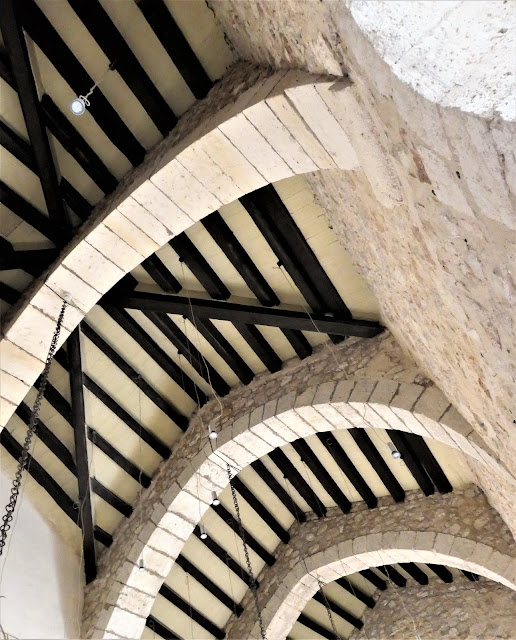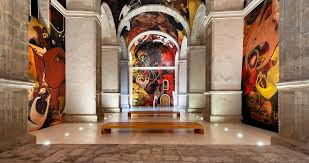Alarcón is a small village located in the province of Cuenca, in the autonomous community (Comunidad) of Castila-La Mancha, about 164 km (102 mi.) from Valencia. Its population in 2014 numbered 149 people. One estimate, however, is that more than 40,000 people visit the village each year (or at least did until recently...)
A major reason they make the trip is to see castle, the castle's out-buildings, and the town itself - all of which are well-conserved. Another reason is the dramatic siting of the castle and town. Perched on a hill overlooking the Júcar River (and now dam) on one side and a dramatic gorge on the other, the landscape is fairly staggering.
My reason for visiting was more mundane: go anywhere outside of Valencia to further celebrate the conclusion of the months-long lockdown. Alarcón was altogether a surprise.
"Of Iberian and Roman origins, Alarcón first appears in recorded history at its occupation by the Arabs, to whom it owes the construction of the primitive castle on which the existing one is based. The history of Alarcón is governed by its role as a stronghold; however, the castle is not the town’s only precious heritage: it also claims a rich architectural variety, both religious, as well as the Hermitage of Santa María de la Orden), and civil (the town hall, the House of Villena, and the Castañeda Palace).
The town of Alarcón was declared the site of a Historic-Artistic Grouping (Conjunto Histórico-Artistico) on July 3, 1981."
(Wikipedia)
The two surviving watchtowers that protected the castle at a distance.
At the bottom of the photo, a bridge, originally dating from Roman times.
The entry progression to the the castle and town.
Castle of Alarcón
"Of Muslim origin, this medieval fortress was constructed in the 8th century and conquered by King Alfonso VIII in 1184. The castle sits atop a promontory inside a bend of the Júcar River, creating a formidable stronghold whose battlements provide an impressive view to the border with Valencia. The keep, built around 1460 by Castilian nobleman Juan Pacheco, serves as the fortress’s trademark feature.
The historical figure Juan Manuel, Prince of Villena, who wrote the Tales of Count Lucanor, once lived within the castle walls.The fortress was restored on various occasions throughout its history. In 1963, after years of neglect, the castle was expropriated from the Torrijos family by politician Manuel Fraga Iribarne and subsequently restored by the national tourism organization, who opened its doors as a parador hotel in 1966."
(Wikipedia)
(Wikipedia)
Today, the castle serves as a Parador, the chain of hotels operated by the Spanish government that are either located in renovated historic structures or in new structures with panoramic views of historic locales.
This particular one, the Parador de Alarcon (Cuenca), is relatively modest in size with only eight double occupancy rooms and two suites that are located within the tower itself. Its courtyard is also fairly small, but there are two dramatic public spaces on the ground floor that now serve as a lobby/bar and a restaurant.
This particular one, the Parador de Alarcon (Cuenca), is relatively modest in size with only eight double occupancy rooms and two suites that are located within the tower itself. Its courtyard is also fairly small, but there are two dramatic public spaces on the ground floor that now serve as a lobby/bar and a restaurant.
Capping the experience is a visit to the castle's battlements. These provide a spectacular view of the surrounding countryside and for me at least, a dramatic sense of space and time from centuries past.
(Inside the castle walls.)
The Town
Lacking tourists, the town has the feel of a stage set: the quintessential Spanish village of history. Missing the people - (of which, without even tourists, there are very few); and of course the "out-of-place" cars, the sense of a place frozen in time was very much at the forefront of the experience. Villages, towns, cities grow, age, and change. Sometimes, this can be a good thing. Alarcon is obviously having none of that.
Ayuntamiento de Alarcon (City Hall)
at the Plaza Infante Don Juan Manuel
Church of Santa Maria del Campo
Constructed in the Plateresque style in the early 16th century, the church features Gothic tracery in the vaults. The portal dates from the middle of the same century and was built by Esteban Jamete of Orleans.
Church of Santo Domingo de Silos
"This 13th century church was built in the late Romanesque style. Of the original structure, both the semicircular apse in the nave and the southern portal have been preserved...In the 16th century, the square tower and the walls of the nave were built following Renaissance designs, while the Baroque period saw the modification of the ceiling with a ribbed barrel vault . Today the church has been adapted for use as an exhibition hall and auditorium. It was declared a national monument on February 19, 1992."
(Wikipedia)
(Closed at time of visit.)
(Former) Church of San Juan Bautista
In 1994, the young Spanish painter, Jesús Mateo, began the project of covering the totality of the old structure in a set of mural paintings, officially sponsored since 1997 by UNESCO for its "global artistic interest." The late 16th century building which is located on the Plaza Don Juan Manuel (see above) is now an art center. It too was closed at the time of our visit. A disappointment, if the photos (by others) are any indication of the work Mateo has done.
Other Signs of Life
The public trash containers throughout the town are camouflaged with quotes from the town's famous author.
"Never get depressed for suffering poverty, because there are others that are
poorer that you will one day encounter."
poorer that you will one day encounter."
This one is difficult to translate literally. The meaning is: If you only have friends because of what the friends give you, they will not last long.
The Landscape
IIIIIIIIIIIIIIIIIIIIII
_____________________________________________
Copyright © 2015-2020 Benjamin Clavan

















































